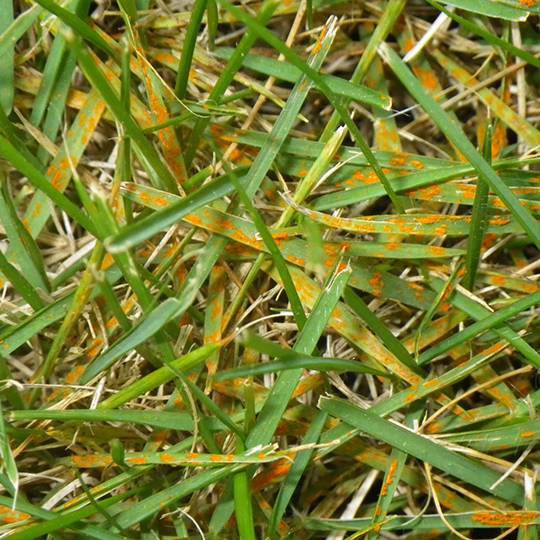
Grasses primarily affected: Kentucky bluegrass, perennial ryegrass, tall fescue.
Lawn rust (puccinia spp.), also known as rust disease, is a powdery substance (usually orange or rusty in color) that appears in spots or completely coating a grass blade that can brush off easily.
A relatively unusual lawn disease, lawn rust is easily identifiable when the individual grass blades are examined up close. The orange or rust-colored fruiting bodies that eventually develop on grass blades are a result of infection by the various types of lawn rust fungi. This helps to differentiate it from other lawn diseases. When in its powdery form, lawn rust spreads easily, by wind, grass blades brushing against one another, and from people and animals walking through it.
Lawn rust prefers shade, heat, and humidity. It also thrives in soils low in nitrogen, which sets it apart from other lawn diseases.
Lawn Rust Signs and Symptoms
At the beginning of infestation, lawn rust looks like small, yellow dots on grass blades. From a distance it appears as a random light patch in a yard of normal grass. As the disease develops, the dots lengthen and eventually rupture, producing the rust-colored tufts of the powdery residue that gives the disease its name.
Less severe infections cause discoloration and make grass grow slower than usual. Severe lawn rust infections color the entire lengths of grass blades, eventually causing the grass look shredded and to point downwards rather than standing upright. Any level of infection can make your lawn more susceptible to other lawn diseases while the grass is in its weakened state.
Lawn Rust Prevention
Prevent lawn rust by ensuring that your grass is growing thickly. Fertilize with a nitrogen-based fertilizer and water for long periods at long intervals instead of short periods at short intervals. A thick lawn helps fight off disease and pests that are attracted to weakened grass. Aeration is important, as fungi often prefer to grow in moist soil with poor drainage. Minimizing the shade your lawn gets can help kill lawn rust and prevent it from reappearing.
Fungicides should only be applied to grass with lawn rust infestations in the most severe cases and before the disease goes dormant for the winter. Lawn rust may go away on its own if it is properly fertilized.
Any questions? Call Cardinal Lawns today to discuss your options for making your lawn look its best.
Need Help with Lawn Rust?
Call Cardinal Lawns today at 614-808-4446 and let's talk about how we can help treat for Lawn Rust and other common Ohio lawn diseases.
Get a Free Quote